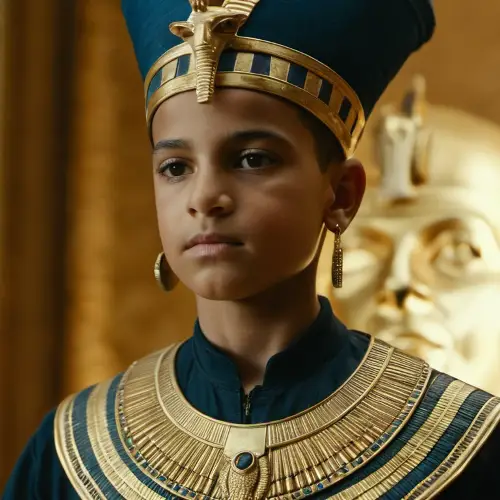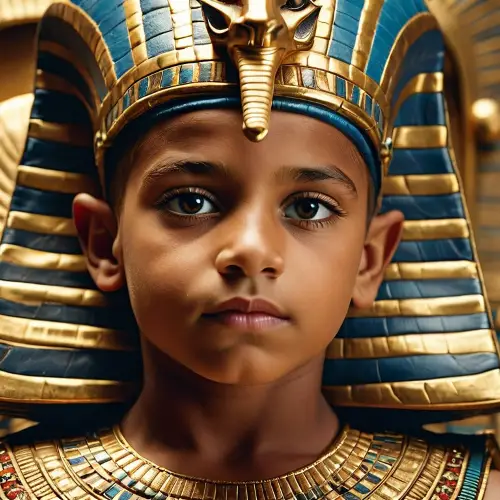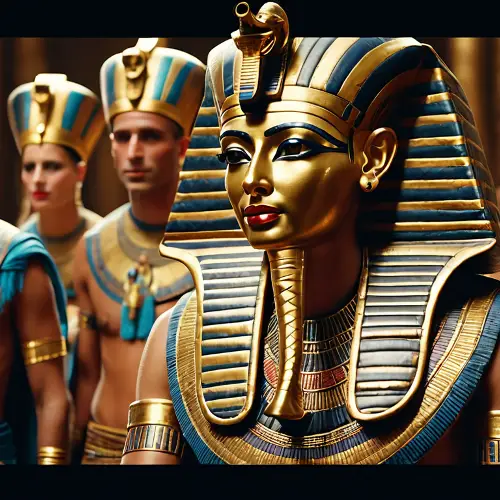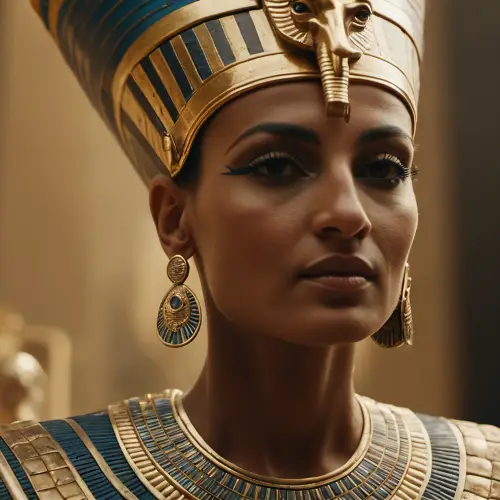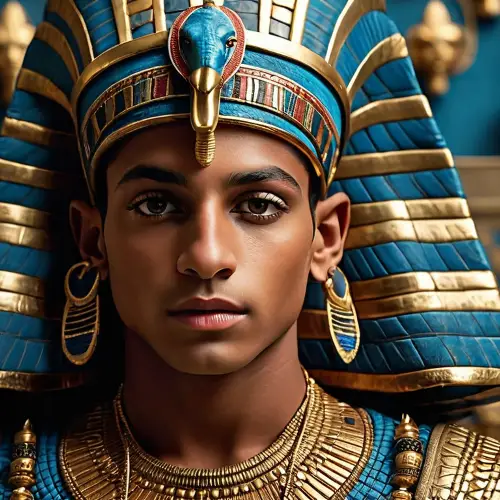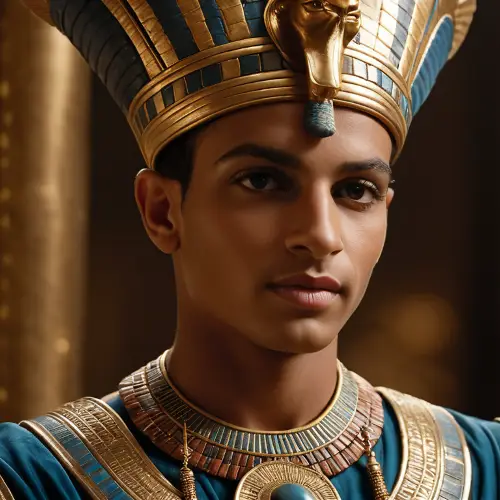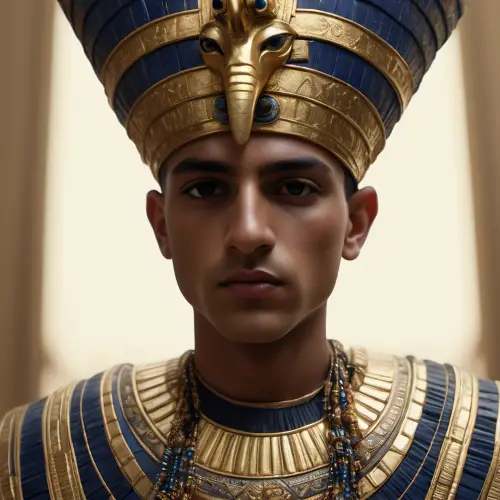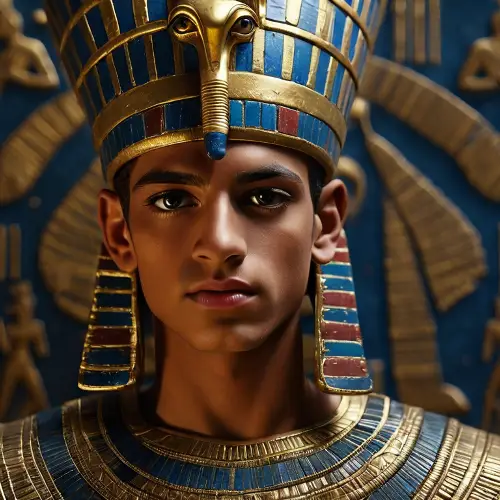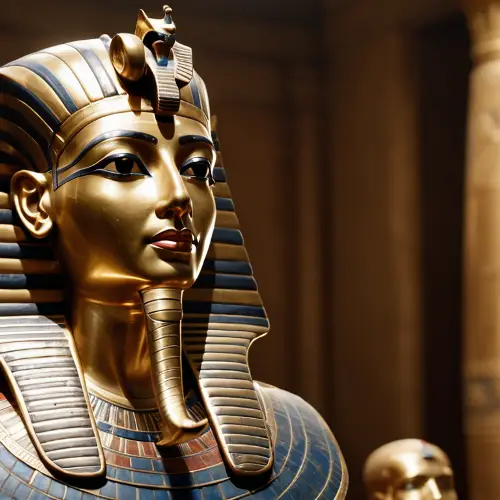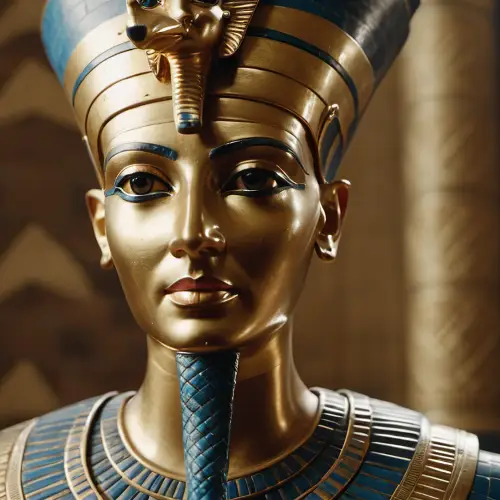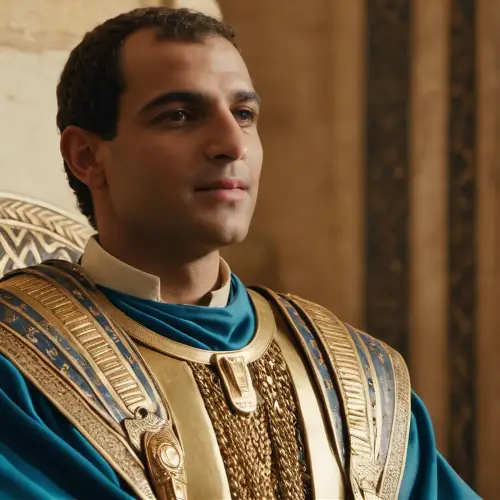Tutankhamun's coronation ceremony at the age of 9 unfolds with the young pharaoh's regal back view, surrounded by the bustling crowd in the royal palace.
More Like This
Tutankhamun's coronation ceremony at the age of 9, adorned in royal regalia, captures the grandeur of ancient Egypt.
Tutankhamun, ascending to the throne at the age of 9, dons the regal attire of an Egyptian pharaoh, his youthful visage illuminated by the ancient splendor of Egypt.
A scene depicting 9-year-old Pharaoh Tutankhamun's back as he delivers a speech in front of a vast crowd.
A scene illustrating the side view of 9-year-old Pharaoh Tutankhamun delivering a speech in front of a vast crowd.
Tutankhamun seated on the throne. In a regal setting, the young pharaoh exudes authority, adorned with royal attire and the symbols of power. The scene captures the essence of his reign as he sits majestically on the throne.
Tutankhamun seated on the throne. In a regal setting, the young pharaoh exudes authority, adorned with royal attire and the symbols of power. The scene captures the essence of his reign as he sits majestically on the throne.
Majestic moment of Tutankhamun's grand ceremony captured in a still frame.
A youthful Tutankhamun, Pharaoh of Egypt, portrayed in his early years. He stands with regal grace, adorned in ornate garments reflecting the opulence of ancient Egyptian royalty. The intricate details of his attire and the grandeur of his headdress symbolize the power and splendor of his reign.
A youthful Tutankhamun, Pharaoh of Egypt, portrayed in his early years. He stands with regal grace, adorned in ornate garments reflecting the opulence of ancient Egyptian royalty. The intricate details of his attire and the grandeur of his headdress symbolize the power and splendor of his reign.
A vivid portrayal of Pharaoh Tutankhamun reigning over Egypt from 1334 BC to 1325 BC. The scene includes the Pharaoh's regal presence and the diverse populace of Egypt.
Tutankhamun's majestic crown, adorned with various jewels, emphasizes his grandeur.
In the grandeur of the Egyptian palace, Cleopatra, draped in regal attire, stands beside her young son, Ptolemy XV Philopator Philometor Caesarion. The room, adorned with symbols of ancient Egypt, bears witness to the historic moment as Cleopatra ensures a smooth transition of power.Cleopatras face reflects a mix of maternal pride and sovereign grace as she ceremoniously presents the young heir before the courtiers. The air is charged with the weight of responsibility and the promise of a new reign. The scene captures the essence of a queen securing the future, entrusting her son with the legacy of Egypt.
In the grandeur of the Egyptian palace, Cleopatra, draped in regal attire, stands beside her young son, Ptolemy XV Philopator Philometor Caesarion. The room, adorned with symbols of ancient Egypt, bears witness to the historic moment as Cleopatra ensures a smooth transition of power.Cleopatras face reflects a mix of maternal pride and sovereign grace as she ceremoniously presents the young heir before the courtiers. The air is charged with the weight of responsibility and the promise of a new reign. The scene captures the essence of a queen securing the future, entrusting her son with the legacy of Egypt.
In the grandeur of the Egyptian palace, Cleopatra, draped in regal attire, stands beside her young son, Ptolemy XV Philopator Philometor Caesarion. The room, adorned with symbols of ancient Egypt, bears witness to the historic moment as Cleopatra ensures a smooth transition of power.Cleopatras face reflects a mix of maternal pride and sovereign grace as she ceremoniously presents the young heir before the courtiers. The air is charged with the weight of responsibility and the promise of a new reign. The scene captures the essence of a queen securing the future, entrusting her son with the legacy of Egypt.
Tutankhamun, amidst opulent surroundings, gracefully leans on a staff embellished with precious jewels, showcasing scenes of him using the staff to navigate majestic halls, ascending grand staircases, and presiding over regal ceremonies. The staff, adorned with intricate hieroglyphics, becomes a symbol of his royal presence.
Pharaoh Tutankhamun, the 10th ruler of Egypt's 18th dynasty, depicted in his majestic regalia, adorned with the traditional Egyptian crown and intricate jewelry. The young pharaoh, known for his reign during the New Kingdom, stands with an air of royal authority, symbolizing the grandeur of ancient Egypt.
Pharaoh Tutankhamun, the 10th ruler of Egypt's 18th dynasty, depicted in his majestic regalia, adorned with the traditional Egyptian crown and intricate jewelry. The young pharaoh, known for his reign during the New Kingdom, stands with an air of royal authority, symbolizing the grandeur of ancient Egypt.
Pharaoh Tutankhamun, the 10th ruler of Egypt's 18th dynasty, depicted in his majestic regalia, adorned with the traditional Egyptian crown and intricate jewelry. The young pharaoh, known for his reign during the New Kingdom, stands with an air of royal authority, symbolizing the grandeur of ancient Egypt.
In the opulent halls of Cleopatras palace, a momentous occasion unfolds as Cleopatra, radiant in regal attire, stands before a gathered assembly. Her son, Caesarion, stands beside her, the embodiment of a future ruler.Cleopatra, with a proud and loving expression, places a golden crown on Caesarions head, symbolizing his ascent to power. The courtiers and nobles look on with reverence and anticipation. The room is adorned with rich tapestries and intricate Egyptian motifs, echoing the grandeur of the occasion as the young ruler assumes his role under the watchful guidance of his queen mother.
Tutankhamun issuing commands from the throne. In a commanding stance, the pharaoh directs with authority, surrounded by an air of regality. The scene captures the essence of leadership as Tutankhamun rules from his throne.
The golden sunlight sparkles upon Tutankhamun's palace, illuminating the magnificent entrance in a dazzling display.
The iconic image of Tutankhamun in the center of ancient Egypt, his visage immortalized in the famous bust, embodying the mystique and allure of the pharaohs.
Emerging from the shadows, a radiant glow unveils the presence of Tutankhamun. The play of light accentuates the mysterious aura surrounding him, creating an enigmatic and captivating atmosphere.
Emerging from the shadows, a radiant glow unveils the presence of Tutankhamun. The play of light accentuates the mysterious aura surrounding him, creating an enigmatic and captivating atmosphere.
An artistic representation of Pharaoh Tutankhamun reigning over Egypt from 1334 BC to 1325 BC.
An artistic representation of Pharaoh Tutankhamun reigning over Egypt from 1334 BC to 1325 BC.
In the vibrant spring of 51 BCE, bathed in the warm glow of sunlight, the young Ptolemy XIII assumes his fathers mantle as the Pharaoh of Egypt. His face, a mixture of youthful innocence and the weight of responsibility, reveals the essence of a burgeoning leader.Seated beside him on the throne, Cleopatra, his sister and co-ruler, the epitome of regal grace, signifies unity and strength. Their marriage becomes a symbol of power and consolidation, promising to guide Egypts destiny hand in hand. The scene encapsulates the tender moment of an alliance, where two hearts, still in their formative years, pledge to grow together.
When Tutankhamun is alive, the scene where he wears a mask and attends the succession ceremony. The collars of Nemes on both sides of the mask represent the authority of the pharaoh, and the cobras and eagles on the foreheads symbolize the goddesses of Egypt and the Sanga.
The discovery of the ancient mummy of Tutankhamun unfolds. As the archaeologists carefully unveil the layers of linen and wrappings, the preserved features of the young Pharaoh emerge, showcasing the artistry of ancient Egyptian embalming. The dimly lit chamber adds an aura of mystery and reverence to the moment.
The discovery of the ancient mummy of Tutankhamun unfolds. As the archaeologists carefully unveil the layers of linen and wrappings, the preserved features of the young Pharaoh emerge, showcasing the artistry of ancient Egyptian embalming. The dimly lit chamber adds an aura of mystery and reverence to the moment.
A powerful mist emanates from Tutankhamun's hand, filling the air with intensity.
Pharaoh Tutankhamun adorned in a golden crown, wearing a symbolic cobra-shaped headdress embracing his shoulders. His face depicted with intricate eyeliner, a thick beard, and smooth skin. Clad in a lavish golden garment that drapes his body.
Illustrating the mystery surrounding Tutankhamun's death, envision the young pharaoh lying peacefully in his burial chamber, surrounded by the treasures of his reign. The dim glow of flickering torches reveals the intricate details of his funeral mask, symbolizing both regality and the journey to the afterlife. An air of solemnity lingers as historians ponder the secrets concealed within the ancient tomb.
In a vivid scene from Tutankhamun's life, he proudly wields his dagger on the battlefield, striking down foes with confidence. The dagger gleams brilliantly, reflecting the light of the sun, creating a dazzling spectacle as he demonstrates both skill and regal prowess.
In the resplendent halls of Alexandria, Cleopatra, adorned in regal attire, ascends the throne alongside her son, Ptolemy XV Philopator Philometor Caesarion, a mere thirteen years old. The room, adorned with opulent Egyptian decor, bears witness to the historic moment of succession.Cleopatras face reflects a blend of maternal pride and sovereign determination as she places the diadem on her young sons head. The air is charged with a sense of continuity and the promise of a new era as Cleopatra, with graceful authority, establishes her son as the heir to the throne. The scene captures the essence of a queen securing the legacy of her lineage.
In the golden halls of Alexandria, Cleopatra, adorned in royal garments, solemnly presents her 3-year-old son, Caesarion, as the co-ruler Pharaoh Ptolemy XV. The room, adorned with symbols of Egyptian majesty, becomes the stage for a pivotal moment in history.Cleopatras face reflects a mix of maternal tenderness and regal authority as she places the diadem on the young Caesarions head. The air is charged with the promise of a new era as mother and son, in a poignant tableau, embody the continuity of Egypts lineage. The scene captures the essence of a queen securing her sons legacy and entrusting him with the weighty mantle of rulership.
In the golden halls of Alexandria, Cleopatra, adorned in royal garments, solemnly presents her 3-year-old son, Caesarion, as the co-ruler Pharaoh Ptolemy XV. The room, adorned with symbols of Egyptian majesty, becomes the stage for a pivotal moment in history.Cleopatras face reflects a mix of maternal tenderness and regal authority as she places the diadem on the young Caesarions head. The air is charged with the promise of a new era as mother and son, in a poignant tableau, embody the continuity of Egypts lineage. The scene captures the essence of a queen securing her sons legacy and entrusting him with the weighty mantle of rulership.
In the golden halls of Alexandria, Cleopatra, adorned in royal garments, solemnly presents her 3-year-old son, Caesarion, as the co-ruler Pharaoh Ptolemy XV. The room, adorned with symbols of Egyptian majesty, becomes the stage for a pivotal moment in history.Cleopatras face reflects a mix of maternal tenderness and regal authority as she places the diadem on the young Caesarions head. The air is charged with the promise of a new era as mother and son, in a poignant tableau, embody the continuity of Egypts lineage. The scene captures the essence of a queen securing her sons legacy and entrusting him with the weighty mantle of rulership.
Archaeologists uncover Tutankhamun's staff, revealing a moment of excitement and discovery within the ancient pyramid.




